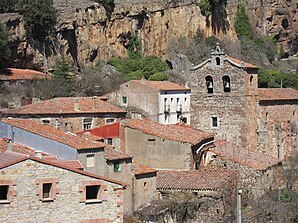Anguita (Guadalajara)
| Anguita municipality | ||
|---|---|---|
 Anguita - Barrio Hoz
|
||
| coat of arms | Map of Spain | |

|
|
|
| Basic data | ||
| Autonomous Community : |
|
|
| Province : | Guadalajara | |
| Comarca : | Serranía de Guadalajara | |
| Coordinates | 41 ° 2 ′ N , 2 ° 22 ′ W | |
| Height : | 1125 msnm | |
| Area : | 127.22 km² | |
| Residents : | 156 (Jan 1, 2019) | |
| Population density : | 1.23 inhabitants / km² | |
| Postal code : | 19283 | |
| Municipality number ( INE ): | 19032 | |
| administration | ||
| Website : | Anguita | |
Anguita called a location and several hamlets (Pedanías) existing municipality ( municipio ) with 156 inhabitants (at January 1, 2019) in the northeast of the province of Guadalajara in the Autonomous Community of Castile-La Mancha . The Catholic parish belongs to the diocese of Sigüenza-Guadalajara . Anguita is on the Camino del Cid .
Location and climate
The place Anguita is located on the Río Tajuña in the mountainous northeast of the province of Guadalajara near the border with the province of Soria at an altitude of about 1125 m . The distance to the southwestern provincial capital Guadalajara is approx. 87 km (driving distance). The city of Sigüenza is about 28 km to the west; the small but historically and culturally significant place Medinaceli is only about 26 km to the north. The climate is temperate to warm; Rain (approx. 515 mm / year) falls over the year.
Population development
| year | 1857 | 1900 | 1950 | 2000 | 2017 |
| Residents | 707 | 930 | 708 | 275 | 176 |
The increasing mechanization of agriculture as well as the abandonment of small farms and the resulting loss of jobs led to a significant decline in the population in the second half of the 20th century, even through the incorporation of the formerly independent villages of Aguilar de Anguita, Santa María del Espino, Padilla del Ducado and Villarejo de Medina could not be caught.
economy
For centuries the community lived exclusively from growing grain ( barley and wheat ), which was mainly operated for self-sufficiency ; livestock farming (sheep, goats, chickens) also took place to a small extent. The place Anguita served as a mercantile, craft and cultural center for the hamlets and farmsteads in its area, which have since mostly disappeared. Today agriculture still plays the most important role, but there is also income from tourism (rental of holiday homes).
history
Two Celtiberian fortresses (castra) have been uncovered in the municipality ; however, neither Roman nor Visigoth traces were discovered. After the Arab-Moorish conquest , large areas in the north of the Iberian Peninsula were depopulated , which began in the 10th century and in the second half of the 11th century under Alfonso VI. Complete reconquest ( reconquista ) of New Castile , which reached its preliminary climax in 1085 with the capture of the city of Toledo, about 200 km further south-west, and was repopulated ( repoblación ) . In the high Middle Ages the region belonged to the Villa y Tierra de Medinaceli ; During this time, the population of the city of Medinaceli and the surrounding areas was excommunicated because they refused to contribute to the cost of building the new cathedral in Sigüenza .
Attractions
- Anguita
- The remains of two Celtiberian castra can be found in the vicinity of the village . The richly decorated breastplate made of bronze in the form of a round shield with attached leg protection was also found here, which is now in the Museo Arqueológico Nacional in Madrid .
- The medieval “stork tower ” (Torre de la Cigüeña) is the town's landmark. Immediately next to it are the approximately two meter high foundation walls of a watchtower ( atalaya ) .
- The parish church ( Iglesia de San Pedro ) has both Romanesque and Gothic parts.
- The portal facade of a late medieval hospital is in the center of the village.
- Two hermit churches (Ermita de Nuestra Señora de la Lastra and Ermita de la Soledad) enrich the townscape.
- Aguilar de Anguita
- In the vicinity of the village are the remains of a small bridge that, according to local tradition, dates back to Roman times.
Castrum of La Cerca
Necropolis of Portillo
literature
- Javier Serrano Copete: Una historia de Anguita: el pueblo y su entorno. AACHE Ediciones, Guadalajara 2008, ISBN 978-84-96885-50-9 .
Web links
- Anguita, Castro Celtibérico de Hocincavero - information (Wikipedia, Spanish)
- Anguita, Castro Celtibérico de La Cerca - Photo + Info (Spanish)
- Anguita Photos
- Anguita - photos + info (spanish)
Individual evidence
- ↑ Cifras oficiales de población resultantes de la revisión del Padrón municipal a 1 de enero . Population statistics from the Instituto Nacional de Estadística (population update).
- ↑ Anguita - climate tables
- ^ Anguita - population development






